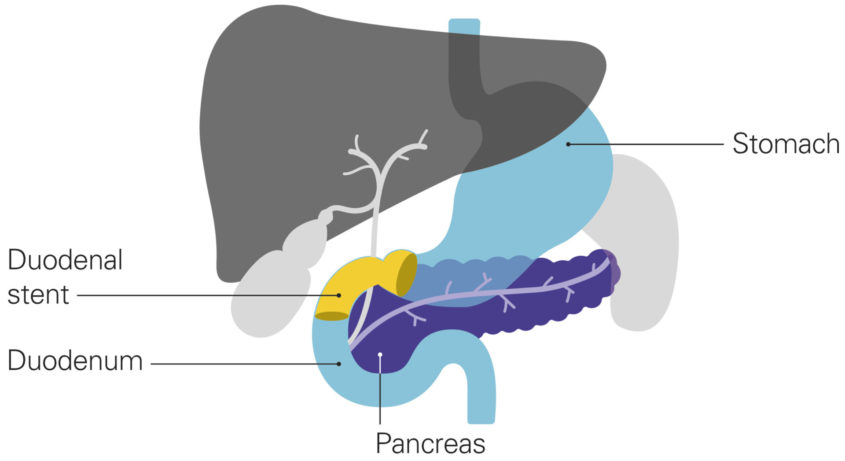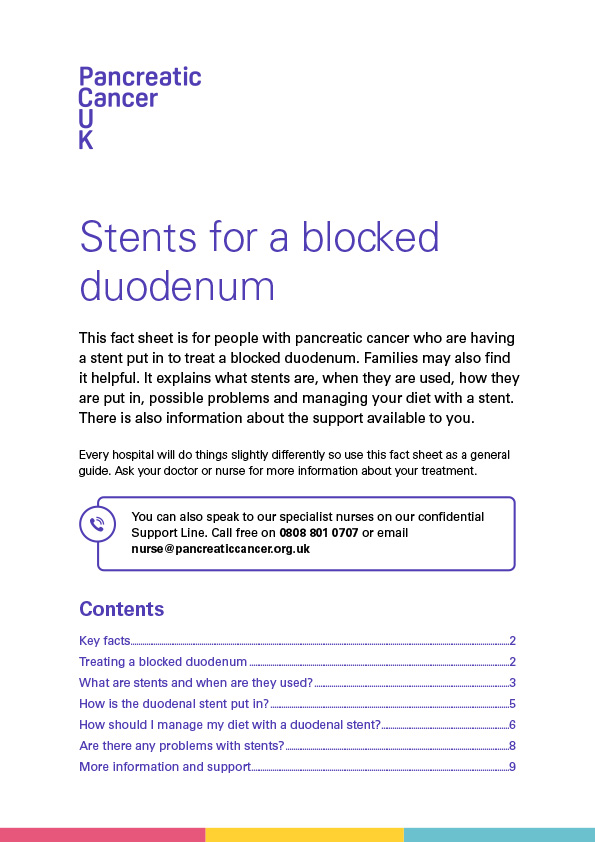Advantages and disadvantages of duodenal stents
Advantages
- The stent should open the blocked duodenum and treat your sickness.
- You should start feeling better quickly, normally within a couple of days of having the stent put in.
- Treating symptoms may mean you can start or continue treatment for the cancer, such as chemotherapy.
Disadvantages
- The stent may get blocked and the symptoms you had before may come back.
- Some people may still feel sick after having a stent put in. If this doesn’t get better speak to your doctor.
- There is a small chance of your stent moving after it has been put in. If this happens it may need to be replaced.
- There is a small risk of complications such as a hole in the duodenum or bleeding. A hole in the duodenum can also cause infection.
How is the duodenal stent put in?
You may go into hospital the day before the stent is put in, or on the day. You will be asked not to eat or drink for at least eight hours before to make sure that your stomach and duodenum are as empty as possible. Tell your doctor or nurse if you take blood thinning medicine or have diabetes, as this might affect your care before the stent is put in.
You will have a sedative, which will make you very sleepy and relaxed. A tube with a camera on the end, called an endoscope, is put in through your mouth and down into the duodenum. A fine wire is then used to guide the stent into place inside the duodenum.
The procedure will take around 30-40 minutes.
What happens afterwards?
Once the sedative wears off, you will usually be able to drink. Once you can drink without problems you will be able to eat. At first you will have softer foods so that the stent does not get blocked. Sometimes it can take a while for your stomach to start emptying properly again. You may be given medicine to help your stomach empty.
You may need to stay in hospital overnight, but this will depend on how quickly you recover. If your stent gets blocked, you may be or feel sick. If this happens after you have left hospital, contact your doctor or nurse. Or go to A&E if you can’t reach them.
Will I feel better?
After the stent has been put in your symptoms should begin to improve. For example, you should stop feeling sick and find it easier to eat.
Some people may still feel sick after having a stent put in. This is because food will move through the stent differently to how it moves through the duodenum. This means food may stay in the stomach for longer. Speak to your doctor if this does not get better. They may give you anti-sickness medicines and suggest changes to your diet.
You will need to be careful what you eat to make sure the stent does not get blocked. If you need advice or are having problems speak to your nurse or dietitian.
Are there any problems with stents?
Blockages
The main problem with stents is that they can get blocked. This can be caused by the cancer growing through the stent or by food building up inside it. If you start feeling or being sick again, speak to your doctor or nurse. Or go to A&E if you can’t reach them. They can check if the stent is blocked. If this happens another stent can be put in to treat the blockage. Your nurse or dietitian should tell you what foods to stop the stent getting blocked.
Read more about eating and diet.
Stent moving out of place
Sometimes stents can move out of place. If this happens the stent is usually removed and a new one put in. Tummy pain or vomiting may be signs that your stent has moved. Speak to your doctor or nurse if you get any of these symptoms. They can decide if the stent needs to be replaced.
Discomfort
Occasionally stents cause discomfort in the upper tummy when they are first put in. This is not common and normally gets better over a few days.
Other possible problems
There are some other possible problems from having a stent put in, but these are very rare. For example, there is a risk of the procedure causing a hole in the duodenum during or after the stent is put in. This can cause bleeding, being sick, or an infection. There is also a small risk of infection caused by the stent getting blocked.
If you have any side effects or unusual symptoms after you have left hospital, phone your nurse or doctor. If you can’t reach them, go to A&E. If you have any questions or worries about having a stent put in, or after the stent has been put in, speak to your medical team.




